- How Much Weight Can You Realistically Lose in 3 Months? - January 14, 2024
- How To Lose 1kg a Week (Guaranteed) - August 20, 2023
- How To Count Calories (or Estimate) and Stay on Track When Eating Out at Restaurants - July 25, 2023
Tracking calories can be really easy, but sometimes it can also be really f**king difficult.
For example, let’s say you go to the shop and grab a bag of Beef Jerky.
You scan the barcode on the back with My Fitness Pal and it clocks in at 200 calories, bosh, done. Easy peasy.
The problem is, we’re not always eating food out of packets with barcodes, and even when we do, we’re not necessarily eating all of that food.
A great example is if you’re batch cooking for several days, or you’re cooking a single meal like a lasagne or a chili that will be divided between 2 or more people.
In situations like this, It can be really tricky to track accurately. This is for a few reasons;
- There are a lot of different ingredients
- Some of the ingredients may not come in packets with barcodes
- You may need to weigh the ingredients
In cases like this, counting calories can certainly be a little trickier and more time-consuming, but it’s really no big deal and still won’t take you more than a few minutes in total.
The beauty is that when you’re cooking a big meal, you’ll likely have some ‘dead time’ waiting for the oven to heat or the water to boil, and this time can be used to get organized and track everything.
The other positive is that you can save ‘recipes’ in My Fitness Pal, so once you’ve made a specific recipe once, you won’t need to go back and track everything again, you can just re-track the recipe you previously saved.

Before we go on, I need to go into a bit of detail about tracking calories in general and how to track them accurately;
HOW TO TRACK CALORIES PROPERLY
Tracking calories properly and accurately is really important.
Eating 1,600 and 1,800 could be the difference between losing weight, and staying the same weight.
Having said that, you can never hope to be 100% accurate with your tracking.
Why?
Well firstly, the calories listed on food packaging may not be 100% accurate. Second, your scales may not be 100% accurate, and finally, the values in My Fitness Pal may not be 100% accurate.
But you shouldn’t use these as excuses not to track, or to rationalize in your head that ‘tracking is pointless because it’s not accurate.
I’ll tell you this right now; tracking is not accurate, but it’s a HELL of a lot better than just not tracking at all.
After all, that’s what you’ve been doing all your life right?
And I’m guessing that you’re reading this post because you maybe want to drop some fat.
Well, to achieve something you’ve never achieved before, you need to do things you’ve never done before and trust me, tracking calories is one of those things.
So, how do you track calories accurately and properly?
- Use My Fitness Pal. Just do it. Yes there are other good apps out there for tracking calories but My Fitness Pal has the biggest database of foods, which means that weird exotic fruit you want to track will probably be in there. You can also add friends and see their progress which can be super motivating. It also syncs with other popular fitness apps like Fitbit. Need any more reasons? Just do it.
- Weigh your food As mentioned, sometimes you can just scan the barcode on the pack and be done with it, but some of the time, that’s not possible. This should be an obvious one but If you’re eating meat from the butchers or lose potatoes or rice from the supermarket, for example, you’ll need to weigh it out using scales. DON’T just guess
- Track raw OR cooked If you are weighing your food raw then track it raw. There’s a big difference between 100g of raw chicken and 100g of cooked chicken. 100g of cooked chicken will be a lot more calories (chicken loses around 25% of its weight when it’s cooked). 135g of raw chicken makes 100g of cooked chicken (more on this later)
- Don’t miss important ingredients Here’s the good news. You don’t need to track everything. For example, salt contains zero calories so there’s absolutely no need to track that. Similarly, herbs that you use sparing will contain a negligible amount of calories so there’s really no need to track those. It is important to know what seemingly insignificant ingredients you definitely DO need to track though, Cooking oil is a great example. Just one tablespoon (10g) can contain 80 calories. That’s HUGE if you drizzle it liberally over everything you eat.
- Stick to verified foods in My Fitness Pal, you’ll notice that certain foods have a small green tick next them that looks like this
. This means that the entry has been deemed to be accurate by My Fitness Pal (users can add their own foods). If it’s a common food, there will likely be lots of verified entries for it. If not, don’t sweat. You can read more about verified foods here
- Track As You Go This means when you eat something, you track it. Don’t think you can just ‘leave it ‘til the evening’ or even the next day. You WILL forget things. And yes, those little things matter. A spoon of sugar here and a handful of cashew nuts there can easily add up to a couple of hundred calories a day, and 200 calories per day is 6,000 calories over a month. That’s almost 2lbs (1kg) of weight you didn’t lose just because you were slack with your tracking (yes that rhymes). Even better, track proactively. If you have a rough idea of what you’re going to be eating and drinking, add it to My Fitness Pal ahead of time. This has two benefits; firstly, you can’t forget to track it (because you already did), and second, you’ve already put up a psychological roadblock to stop you from eating more
- Don’t avoid tracking ‘cheat’ days Tracking calories every single day is of course not practical, but avoid the temptation to avoid tracking on ‘cheat’ or high-calorie days. These are the times when it’s most important to track. If you don’t know your rough intake on these days then you won’t know how to compensate on other days.
If you can do all of these things and get to the point where you’re tracking calories accurately and consistently, you realise that as long as you’re in a calorie deficit it doesn’t really matter what you eat, you’ll still lose weight. This is the real beauty of tracking calories!
Ok now we know how to track calories properly, let’s get into a practical example of how you might do it for a home-cooked meal.
STEP BY STEP GUIDE TO TRACKING A HOMEMADE MEAL
Most of the tips mentioned above apply directly to this process, so we’re going to talk through step-by-step cooking a chicken stir fry with noodles, veg and sweet and sour sauce.
You might say this is far from ‘homemade’ as all of it is from a packet, but this is the reality of cooking today. Even prepping something from scratch means using packaged food so this is probably reflective of what most people do.
- LAY OUT ALL YOUR INGREDIENTS
Get everything laid out in the kitchen so you know exactly what you’re using in your cooking. Get organized and lay all your ingredients out.
You could even track everything at this stage if you wanted to so you can just focus on cooking. Of course, you may not know how much sauce you want to use, for example, so you might prefer to track as you go.

- CHOP AND WEIGH THE MEAT
The chicken is the first thing we’re going to cook as it takes the longest, you can weigh it before you chop, but I like to chop first. Either way, weigh it on a bowl on the scales (be sure to zero the scales once you’ve put the bowl on!.

- TRACK THE MEAT
We’ve got 278g of chicken here so that’s 306 calories (note below that I’ve made sure I’ve chosen raw chicken in My Fitness Pal so I get accurate numbers!
- START COOKING THE MEAT
Pretty self-explanatory this one, cook the chicken until it’s around 80% done and then we can start adding the noodles and veg. I don’t use cooking oil as the calories are insane, instead, I use fry light spray which is one calorie per spray. I use about 6-10 sprays and I don’t track this.
- TRACK THE NOODLES
I’m using one pack of these noodles which is 233 calories. I don’t need to weigh these myself because they’re already portioned out. So far so good.
- ADD THE NOODLES TO THE PAN
The noodles take the next longest to cook so add them to the pan with the chicken.
- TRACK THE VEG
Again, I don’t need to weigh the veg as I’m using the whole pack anyway. It’s just 100 calories for this whole pack of veg. Sidenote: veg has a very low calorie density (i.e. you can eat a lot of it for very few calories) meaning it’s great to eat more of when you’re dieting
- ADD THE VEG TO THE PAN
Veg goes in next as it only needs 3-4 minutes to cook down. I put the denser veg like baby corn in and carrot first and the pak choi in last.
- WEIGH THE SAUCE
I DO need to manually weigh the saice because I’m using a specific portion. In this case, I’m using 194g. Again, put a container on the scales, zero the scales then pout the saice in so you just get the weight of the sauce
- TRACK THE SAUCE
I know i’m using 194g of sauce, so I just need to scan the barcode on the pack to tell me how many calories that is. 128 calories all in.
- ADD THE SAUCE TO THE PAN
The sauce only goes in for about a minute while it coats everything else
- CHECK THE TOTAL CALORIE AMOUNT
That’s it, that wasn’t too hard, was it? In total, we can see that the entire meal came to 769 calories. Not bad at all when you consider there’s a LOT of food there.
- EAT IT
Enjoy. Depending on how your calorie total is doing for the day you might even have room for a cheeky treat afterward…
WHAT ABOUT COOKED VS RAW WEIGHTS?
I mentioned this earlier but it’s so important that I need to labor the point.
Some foods increase in volume when they’re cooked (e.g. rice and pasta) because they take on water when they’re boiled. Other foods decrease in volume when they’re cooked because they lose water (e.g. meat).
Now, just because a food increases or decreases in volume throughout the cooking process, that doesn’t mean it gains or loses calories. It only gains or loses water.
BUT, this does mean you need to be careful when you track things in My Fitness Pal, i.e. if you’re using 100g of raw breast chicken in a recipe, enter 100g of RAW chicken in My Fitness Pal
If you’re using 100g of cooked chicken, enter 100g of COOKED chicken in My Fitness Pal.
Why?
Because the calorie amounts are different. 100g of cooked chicken would have started off as around 135g of raw chicken. So 100g of cooked chicken will have more calories than 100g of raw chicken (100g of raw chicken will end up as around 75g of cooked chicken).
Confused?
This table might help.
| Grams of Raw Chicken Breast | Grams of Cooked Chicken Breast | Calories |
| 1000 | 750 | 1100 |
| 900 | 675 | 990 |
| 800 | 600 | 880 |
| 700 | 525 | 770 |
| 600 | 450 | 660 |
| 500 | 375 | 550 |
| 400 | 300 | 440 |
| 300 | 225 | 330 |
| 200 | 150 | 220 |
| 100 | 75 | 110 |
| 50 | 37.5 | 55 |
So you can easily see that the same volume of cooked chicken breast is higher in calories than the equivalent raw volume.
N.B. These numbers are a rough guide and may vary based on the manufacturer, breed of chicken etc. Don’t get too cough up in this though, scan the barcode on the packet for the most accurate reading.
Click here if you want to know more about tracking and weighing raw vs cooked foods.
A FINAL TIP
If you genuinely find tracking home cooking THAT stressful, difficult or time-consuming, there are other options.
There are plenty of pre-chopped and weighed recipe box subscriptions out there now. The big two in the UK are Gousto and Hello Fresh. If you’re interested, I’ve written a Gousto review on a bunch of the different meals I’ve made using their service.
Essentially you choose which meals you want (there’s a very wide choice), then they send you all the ingredients for those meals all already weighed out. There’s sometimes still some work to do in terms of chopping, mixing and of course, cooking, but it does take the stress out of meal prep, and the best thing? The calories are all listed per portion, so no need to track anything.
The downside? The portions are quite small, but that could be a good thing if you’re trying to drop some weight. Most of the meals come in between 500-850 calories per portion.
One other even more convenient option is using a meal prep company. Again you can buy individual meals or subscribe to a plan where you’ll get sent 4 meals per week (for example). All these require is heating up in the microwave.
Calories and macros are listed, so it’s even easier for you to stay on track.
SUMMARY
Tracking calories; especially when home cooking can take a bit of getting used to, but once you get into the swing of things it should take minutes,
It may not be 100% accurate, but as long as you follow the tips above like using scales and paying attention to cooked vs raw calories, you can get pretty close, and that’s a LOT better than just winging it and hoping for the best (that’s what you’ve always done, right?)
The time it takes really is negligible when you consider the benefits it’ll yield in terms of weight loss, and how you’ll feel when you achieve that weight loss.
And no, you DON’T need to track calories for the rest of your life, but you do need to do it for long enough to get a good understanding of what you’re eating and what relationship that has to your scale weight and body composition.
Learning to track is an investment, and it’s 100% worth it.








Leave a Reply